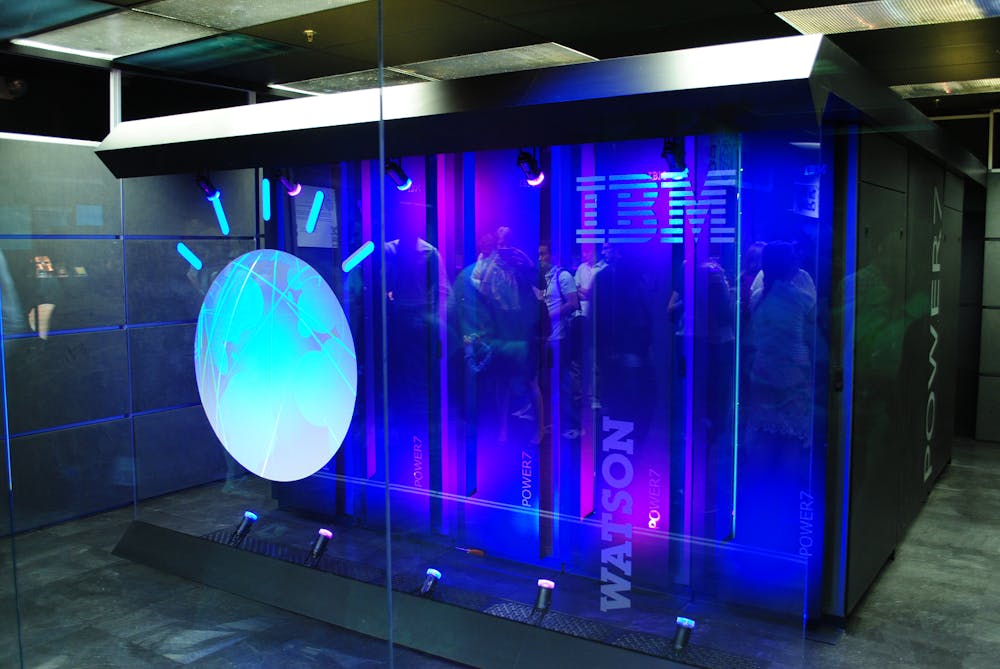Medical institutions have steadily adopted artificial intelligence (AI) technologies and tools to enhance medical services, from image recognition to finding a cure for cancer. The rise and influence of AI and machine learning in health care was the focus of Luis Ahumada’s talk titled “Emerging Machine Learning Methods and the Future of Machine Learning in Health Care” for the Health Sciences Informatics Grand Rounds on March 27.
Ahumada, director of predictive analytics and co-director of the Center for Pediatric Data Science and Analytic Methodology at the Hopkins All Children’s Hospital, discussed the target uses, the benefits and risks, and the predicted future of machine learning methods in healthcare.
Machine learning is employed in various industries to help solve complex problems efficiently, becoming an essential asset for medical providers.
“Machine learning is used to recognize patterns and identify non-linear relationships that are hard with traditional data analysis... machine learning makes it more suitable,” Ahumada said.
As a subdomain of AI, machine learning is responsibly linked to other technological tools such as robotics, speech recognition and optimization. The algorithms powering the proliferation of machine learning have witnessed a steep growth over the past 10 years, especially in 2012 with the advent of image recognition. Ahumada described the surge in the popularity of algorithms as causing new and intriguing waves to address the application of machine learning in healthcare.
“We have a specific knowledge on machine learning... and [we] apply some of these methods blindly to health care to know all sorts of problems... [it’s] exciting because we are writing that,” Ahumada said.
Ahumada discussed the transformation of machine learning methods into four different processes — deep learning, reinforcement learning, convolutional neural networks and generative adversarial networks — all of which have different applications in medicine.
Deep learning involves data representations expressed in terms of other, simple representations to process data, whereas reinforcement learning requires an autonomous agent that learns to perform a task by trial and error without guidance from a human operator.
Ahumada explained the importance of different environments in conducting reinforcement learning, as every action has a positive or negative reward that trains the agent to find better solutions to different scenarios.
Reinforcement learning is one of the most robust techniques used to handle the data of medical research, and Ahumada discussed the use of this machine learning process in sepsis treatment.
“We have to train these algorithms with historical data to try to find out what will be the best policies... whoever survived or has sepsis [can allow us to] learn from that process and learn from the algorithms as we create these models,” Ahumada said.
Ahumada then discussed the use of convolutional neural networks and generative adversarial networks. Convolutional neural networks process data by breaking down overlapping datasets into small neural networks, essentially dividing and conquering an entire dataset.
This method proves to be especially useful for image analysis, as pixels are broken down and max-pooled to identify and learn the image’s characteristics, which is then stored in informational layers.
Generative Adversarial Networks, however, consist of two competing neural networks in a zero-sum framework, in which a generator attempts to trick a discriminator by generating indistinguishable samples. While this machine learning process is still relatively new to health care, it is being employed to generate new patient data, detect anomalies in data and assist in medical image segmentation in retinal image synthesis.
Ahumada emphasized the target uses of machine learning methods in health care and the difficulties accompanying the aspirations to transform the medical landscape. Machine learning is being employed by health-care professionals to essentially outperform doctors at all tasks, eliminate workflow deficiencies, eliminate hospital admissions and readmissions, cure cancer and cause no imminent harm to patients.
Ahumada emphasized the target uses of machine learning methods in health care and the difficulties accompanying the aspirations to transform the medical landscape. Machine learning is being employed by healthcare professionals to essentially outperform doctors at all tasks, eliminate workflow deficiencies, eliminate hospital admissions and readmissions, cure cancer and cause no imminent harm to patients.
“Now that we have this, and this happens soon, we will have a lot of attention in the industry to do things like that,” Ahumada said.
Ahumada further described his involvement in a recent study at the Hopkins All Children’s Hospital, in which he used a deep learning approach to calculate a risk for children with hypoplastic heart syndrome. He also explained his role in developing a calculator to reduce the risk for unnecessary blood transfusion and provide an accurate estimation of blood products for patients with craniosynostosis.
However, there is more work still to be done in collecting and interpreting physiological data to train machine learning methods to produce expected outcomes and diagnoses for medical professionals, which highlights one of the risks of machine learning.
“Over-promising and under-delivering in AI is a problem to the industry... best example is Watson,” Ahumada said, referring to IBM’s computer system.
In addition to the risk of the quality of services offered by machine learning methods, cost and safety remain as other issues, and Ahumada concedes that patient privacy is an issue that should be considered with the use of large data sets in the development of new technologies.
Ahumada addressed the short-term and long-term goals of machine learning methods in health care. Increased use of machine learning in medical specialties and improved efficiency and optimization in imaging are goals health-care services can experience in the near future. Furthermore, he argued, future applications of technology in medicine require machine learning.

















